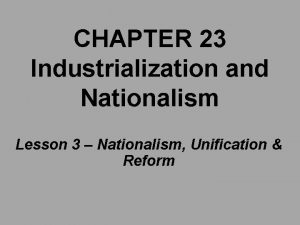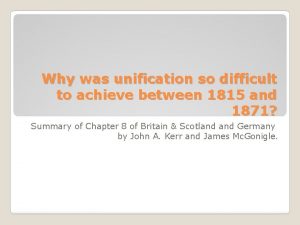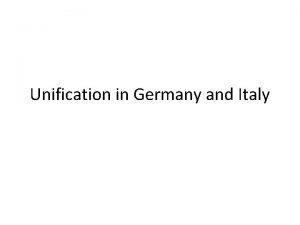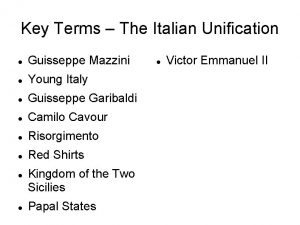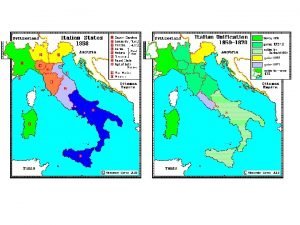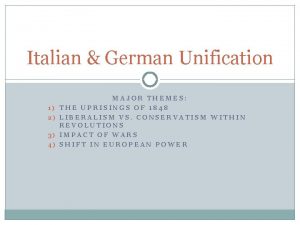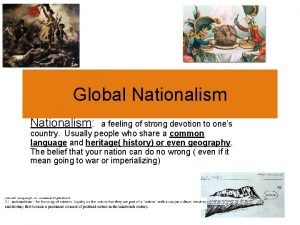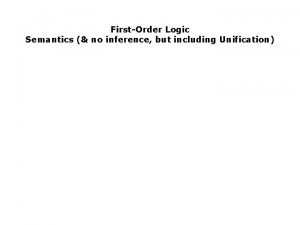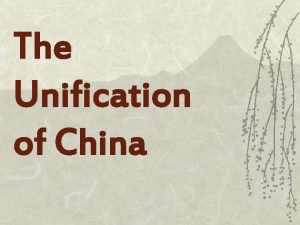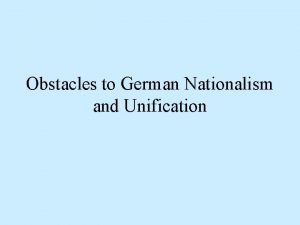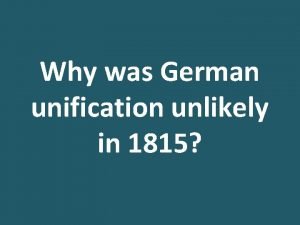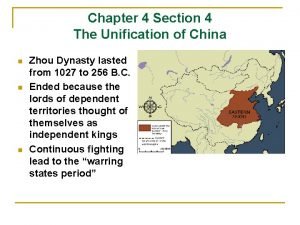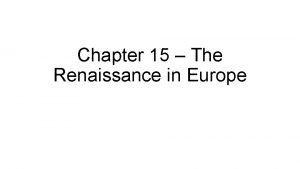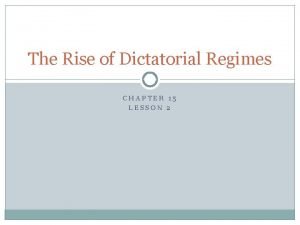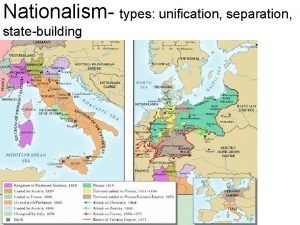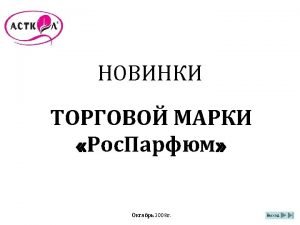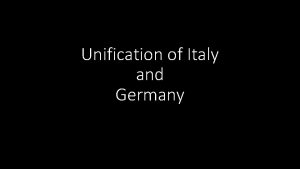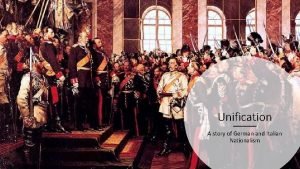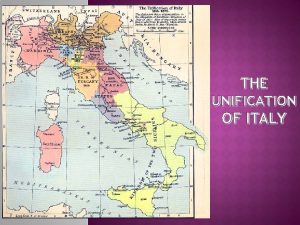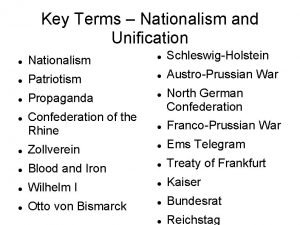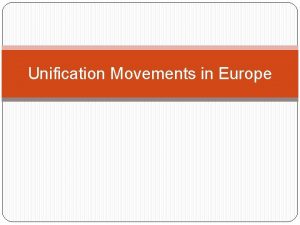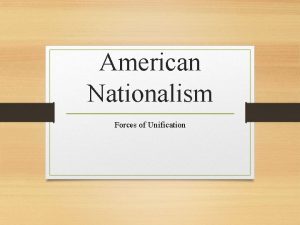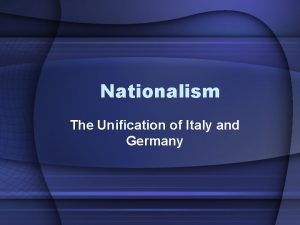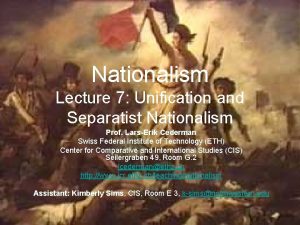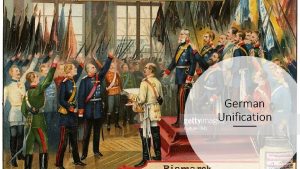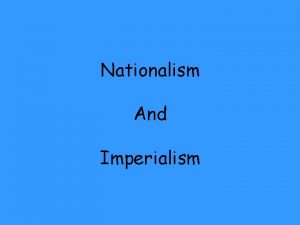CHAPTER 24 Nationalism Italian Unification Nationalism desire for


















































- Slides: 50

CHAPTER 24 Nationalism

Italian Unification Nationalism: desire for national independence 1815: Italian Peninsula was divided into several independent city-states w/ various governments Language and trade barriers prevented unity Mazzini and Young Italy: sought to transform Italy into a sovereign nation-state Began forcing out Austrian influence Pope Pius IX withdrew; other city-states followed Count Cavour (advisor in Sardinia): Gained French support by joining the Crimean War Napoleon III helped force Austrians out of Italy

Garibaldi (military leader in Sicily): 1830: forced into exile – went to S. America Learned to use guerilla warfare (hit and run tactics) 1860: returned to Sicily and gained control Surrendered to Cavour 1861: Italy was one nation with the exception of Rome & Venetia (Victor Emmanuel II) 1871: Victor Emmanuel II moved the capital from Florence to Rome creating complete unity

German Unification Last great European nation to unify 1815: 39 German States - 1871: 1 German nation 1834 – a Zollverein (economic union) was formed Struggle for power between Austria and Prussia = most dominate German state (econ. & mil. ) Otto von Bismarck was dominate prime minister

Three Wars: War against Denmark: Germans forced Danes out of controversial territories (Schleswig & Holstein) Seven Weeks’ War: Bismarck declared war on Austria – defeated them in seven weeks Franco-Prussian War: Bismarck doctored a telegram from Prussia’s King to Napoleon III Formation of an Empire: Jan. 18, 1871 – William I became Kaiser Bismarck became chancellor (chief minister) 25 German states combined to form a new nation

Bismarck’s Realm Concerns: The Center Party (Catholic German political party) 1870: Doctrine of papal infallibility May Laws, limited Catholic power in Germany Pope Pius IX broke diplomatic ties w/ Bismarck tried to make peace (in his “losing battle”) Industrial Growth Deep pit Coal Mining offered abundant cheap fuel Rapid urbanization (rural farmers moved to cities)

Workers and Socialism: Ferdinand Lassalle (Univ. German Workers Assoc. ) Advocated political action to bring change 1875: UGWA merged with the Social Dem. Party Bismarck and the Socialists: 1878: Legislature passed Anti-Socialist Bill – banned all Socialist meetings and publications Tried to gain workers support with State Health Aid 1890: Socialist Dem. Party gained a majority in the legislature The Fall of Bismarck: 1890: upset w/ the new king, Bismarck offered his resignation which was readily accepted by William II

Russia’s Empire Autocracy: govt. in which one person rules with absolute authority Russian Czars: Alexander I: granted a constitution to Poland, then lost interest in social/political improvement Nicholas I: gave secret police unlimited power Alexander II: emancipated serfs to industrialize Terror and Reaction: Michael Bakunin advocated anarchy (no govt. ) Nihilists: rejected all Russian traditions 1881: Alexander II was assassinated Alexander III: promoted Russification (policy of intolerance and persecution of non-Russians)

Revolution of 1905: Nicholas II declared himself an autocrat Was easily influenced by his wife Russian Marxists: Mensheviks: develop an industrial state with a large working class in order to revolt Bolsheviks (Lenin): small party of professional revolutionaries could use force to gain reform More Upheaval: Jan. 22, 1905: soldiers opened fire on 200, 000 peaceful protestors in St. Petersburg Nicholas II allowed for a duma (legislature) October Manifesto: made Soviet Union a const. mon.

Crime is a product of social excess. Give us the child for 8 years and it will be a Bolshevik forever. It is true that liberty is precious; so precious that it must be carefully rationed. No amount of political freedom will satisfy the hungry masses. One man with a gun can control 100 without one. Without revolutionary theory there can be no revolutionary movement.

Austria-Hungary’s Decline Lacked political/geographic unity Revolution of 1848: Metternich opposed/crushed rev. activity France’s Rev. of 1848 spread to Austria; fostered ideas of nationalism and “freedoms” Lost influence over Italian & German provinces under Francis Joseph (conservative king) Dual Monarchy (The Ausgleich): 1867: divided Austria-Hungary into separate empires Shared a monarch, but had different const. /parl. Austria (industrial); Hungary (agricultural)

“Powder Keg” in the Balkans 1875: nationalists in Serbia, Bulgaria, & Romania demanded independence from Turkey The Congress of Berlin (1877): Russia went to war on behalf of the Slavic peoples The Treaty of Stefano (1878): created a large, Russian controlled Bulgarian state Led to jingoism (extreme patriotism) Balkan Conflict: Balkan states began to fight amongst themselves European nations allied with small nations to help give aid

CHAPTER 25 The Age of Imperialism

The Russian Empire in Decline Russia a massive, multi-cultural empire Only approximately half speak Russian, observe Russian Orthodox Christianity Romanov Tsars rule autocratic empire Powerful class of nobles exempt from taxation, military duty Exploitative serfdom

The Russian empire, 18011914

The Crimean War, 1853 -1856 Russian expansion into Caucasus in larger attempt to establish control over weakening Ottoman empire Threatens to upset balance of power, Europeans become involved Russia driven back from Crimea in humiliating defeat Demonstration of Russian weakness in the face of western technology, strategy

Russian Industrialization Alexander II emancipates the serfs (1861) Does not alleviate poverty/hunger Peasants uprooted from rural lifestyle to work for low wage jobs Construction of Trans-Siberian Railroad Socialist and anarchist propaganda spread rampantly People’s Will Movement assassinates Alexander II Pogroms begin against Eastern European Jews

Revolution of 1905 Humiliating defeat of Nicholas II and Russians in the Russo-Japanese War exposes government weaknesses Growing Social Discontent boils over in growing Marxist movements Russian soldiers open fire on protestors sparking panic and threatened revolt by the masses Nicholas II allows for representative government (Duma) October Manifesto is issued

Western Trade in China had restricted the majority of Western trade since the 1750 s The only allowed currency was silver bullion British East India Company began to trade (“smuggle”) opium from India into China By the 1830 s, the Chinese began enforce the ban and the British engaged in military action. Opium War ends with the Unequal Treaties ceding Hong Kong to Britain.

Taiping Rebellion Population growth of 50%; cultivated land remains stagnate Call for the destruction of Qing Dynasty Taiping Platform – led by Hong Xiuquan Abolition of private property Creation of communal wealth Prohibition of footbinding, concubinage Free public education, simplification of written Chinese, mass literacy Prohibition of sexual relations among followers (including married couples) In the end Hong commits suicide and 100, 000 Taipings

The Self-Strengthening Movement (1860 -95) High point in 1860 s-1870 s Slogan “Chinese learning at the base, Western learning for use” Blend of Chinese cultural traditions with European industrial technology Shipyards, railroads, academies Change to Chinese economy and society superficial Strong influence from Confucian scholars and leaders proves to strong for the movement to succeed.

The Boxer Rebellion Society of Righteous and Harmonious Fists (“Boxers”), anti-foreign militia units 1899 fight to rid China of “foreign devils” Misled to believe European weapons would not harm them, 140, 000 Boxers besiege European embassies in 1900 Crushed by coalition of European forces China forced to accept stationing of foreign troops

Foreign Pressure in Japan Europeans, Americans attempting to establish relations U. S. in particular look for Pacific ports merchants Japan only allowed Dutch presence in Nagasaki 1853 Matthew Perry sails gunship up to Edo (Tokyo), forces Japanese to open port Sparks conservative Japanese reaction against Shogun, rally around Emperor in Kyoto – leading to Meiji Restoration allows for “western learning” Establishment of Constitutional Government

The Idea of Imperialism Term dates from mid-19 th c. In popular discourse by 1880 s Military imperialism Later, economic & cultural varieties US imperialism

Motivation for Imperialism Military Political Economic European capitalism Religious Demographic criminal populations Dissident populations

Manifest Destiny Discovery of natural resources Exploitation of cheap labor Expansion of markets

The “White Man’s Burden” Rudyard Kipling (1864 -1936) Raised in India, native Hindi speaker Boarding school in England, then return to India (1882) French: mission civilisatrice

Geopolitical Considerations Strategic footholds Waterways Supply stations Imperial rivalries

Domestic Political Considerations Crises of industrialism Pressure from nascent Socialism Imperial policies distract proletariat from domestic politics Cecil Rhodes: imperialism alternative to civil war

Technology and Imperialism Transportation Steamships Railroads Infrastructure Suez Canal (1859 -1869) Panama Canal (1904 -1914)

Weaponry muzzle-loading muskets Mid-century: breech-loading rifles Reduce reloading time 1880 s: Maxim gun, 11 rounds per second

The Military Advantage Battle of Omdurman (near Khartom on Nile), 1898 Five hours of fighting British: six gunboats, twenty machine guns, 368 killed Sudanese: 11, 000 killed

Communications Correspondence 1830 Britain-India: 2 years After Suez Canal, 2 weeks Telegraph 1870 s, development of submarine cables Britain-India: 5 hours

The Jewel of the British Crown: India East India Company Monopoly on India trade Original permission from Mughal emperors Mughal empire declines after death of Aurangzeb, 1707

Home of a Wealthy Family in Calcutta

British Conquest Protection of economic interests through political conquest British and Indian troops (sepoys)

British Colonial Soldiers

Sepoy Revolt, 1857 Enfield rifles Cartridges in wax paper greased with animal fat Problem for Hindus: beef Problem for Muslims: pork Sepoys capture garrison 60 soldiers, 180 civilian males massacred (after surrender) Two weeks later, 375 women and children murdered British retake fort, hang rebels

British Rule in India Establish Direct Rule Pre-empts East India Company Established civil service staffed by English Low-level Indian civil servants Organization of agriculture Crops: tea, coffee, opium Stamp of British culture on Indian environment Veneer on poor Muslim-Hindu relations

Imperialism in Southeast Asia Spanish: Philippines Dutch: Indonesia (Dutch East Indies) British establish presence from 1820 s Conflict with kings of Burma (Myanmar) 1820 s, established colonial authority by 1880 s Thomas Stamford Raffles founds Singapore for trade in Strait of Melaka Base of British colonization in Malaysia, 1870 s-1880 s French: Vietnam, Cambodia, Laos, 1859 -1893 Encouraged conversion to Christianity

The Scramble for Africa (18751900) French, Portugese, Belgians, and English competing for “the dark continent” Britain establishes strong presence in Egypt, Rhodesia Suez Canal Rhodesian gold. diamonds

A New Africa Implications for justification of imperialist rule European exploration of rivers (Nile, Niger, Congo) Information on interior of Africa King Leopold II of Belgium starts Congo Free State, commercial ventures One of the most brutal mistreatment of the Africans

The Berlin Conference (1884 -1885) Fourteen European nations, United States No African states present Rules of colonization: any European state can take “unoccupied” territory after informing other European powers European firepower dominates Africa Exceptions: Ethiopia fights off Italy (1896); Liberia a dependency of the US

Systems of Colonial Rule Concessionary companies Private companies get large tracts of land to exploit natural resources Companies get freedom to tax, recruit labor: horrible abuses Profit margin minimal Direct Rule “civilizing mission” - Chronic shortage of European personnel; language and cultural barriers French West Africa: 3600 Euro rule 9 million Africans Indirect Rule – use of indigenous institutions

US Imperialism President James Monroe warns Europeans not to engage in imperialism in western hemisphere (1823) The Monroe Doctrine: all Americas a U. S. Protectorate 1867 purchased Alaska from Russia 1875 established protectorate over Hawai’i Locals overthrow queen in 1893, persuade US to acquire islands in 1898

Spanish-Cuban-American War (18981899) US declares war in Spain after battleship Maine sunk in Havana harbor, 1898 Takes possession of Cuba, Puerto Rico, Guam, Philippines US intervenes in other Caribbean, Central American lands, occupies Dominican Repubilc, Nicaragua, Honduras, Haiti Filipinos revolt against Spanish rule, later against US rule (led by E. Aguinaldo)

The Panama Canal President Theodore Roosevelt (in office 19011909) supports insurrection against Colombia (1903) Rebels win, establish state of Panama U. S. gains territory to build canal, Panama Canal Zone Roosevelt Corollary of Monroe Doctrine U. S. right to intervene in domestic affairs of other nations if U. S. investments threatened

Early Japanese Expansion Resentment over Unequal Treaties of 1860 s 1870 s colonized northern region: Hokkaido, Kurile islands, southern Okinawa and Ryukyu islands as well 1876 Japanese purchase warships from Britian, dominate Korea Sino-Japanese War (1894 -1895) over Korea results in Japanese victory Russo-Japanese War (1904 -1905) also ends in Japanese victory

Economic Legacies of Imperialism Colonized states encouraged to exploit natural resources rather than build manufacturing centers Encouraged dependency on imperial power for manufactured goods made from native raw product Indian cotton Introduction of new crops Tea in Ceylon

Colonial Conflict Thousands of insurrections against colonial rule Tanganyika Maji Rebellion against Germans (19051906) Rebels sprinkle selves with magic water (maji) as protection against modern weapons; 75000 killed “Scientific” Racism developed Count Joseph Arthurd de Gobineau (1816 -1882) Combines with theories of Charles Darwin (1809 -1882) to form pernicious doctrine of Social Darwinism
 Chapter 23 lesson 3 nationalism unification and reform
Chapter 23 lesson 3 nationalism unification and reform Unification of italy summary
Unification of italy summary Why was italian unification difficult to achieve
Why was italian unification difficult to achieve German and italian unification compare and contrast
German and italian unification compare and contrast Obstacles to italian unification
Obstacles to italian unification Italian risorgimento timeline
Italian risorgimento timeline Unification prolog
Unification prolog Sardina
Sardina Love my country
Love my country Germany before unification
Germany before unification St an
St an Unification operating model
Unification operating model Fol unification
Fol unification Why did germany avoid “wounding austria too severely”?
Why did germany avoid “wounding austria too severely”? Unification of china
Unification of china Prolog unification
Prolog unification Obstacles to german unification
Obstacles to german unification Unification algorithm example
Unification algorithm example Germany before 1871
Germany before 1871 Gauge coupling unification
Gauge coupling unification Unification of italy class 10
Unification of italy class 10 National unification and the national state
National unification and the national state Stages of german unification
Stages of german unification C section
C section Streetcar named desire scene 1
Streetcar named desire scene 1 Lesson quiz 15-1 the renaissance in europe
Lesson quiz 15-1 the renaissance in europe The rise of fascism worksheet answers
The rise of fascism worksheet answers Formuö
Formuö Novell typiska drag
Novell typiska drag Nationell inriktning för artificiell intelligens
Nationell inriktning för artificiell intelligens Returpilarna
Returpilarna Varför kallas perioden 1918-1939 för mellankrigstiden
Varför kallas perioden 1918-1939 för mellankrigstiden En lathund för arbete med kontinuitetshantering
En lathund för arbete med kontinuitetshantering Adressändring ideell förening
Adressändring ideell förening Tidböcker
Tidböcker Anatomi organ reproduksi
Anatomi organ reproduksi Förklara densitet för barn
Förklara densitet för barn Datorkunskap för nybörjare
Datorkunskap för nybörjare Stig kerman
Stig kerman Att skriva en debattartikel
Att skriva en debattartikel Delegerande ledarstil
Delegerande ledarstil Nyckelkompetenser för livslångt lärande
Nyckelkompetenser för livslångt lärande Påbyggnader för flakfordon
Påbyggnader för flakfordon Lufttryck formel
Lufttryck formel Publik sektor
Publik sektor Lyckans minut erik lindorm analys
Lyckans minut erik lindorm analys Presentera för publik crossboss
Presentera för publik crossboss Vad är ett minoritetsspråk
Vad är ett minoritetsspråk Vem räknas som jude
Vem räknas som jude Treserva lathund
Treserva lathund Epiteltyper
Epiteltyper
